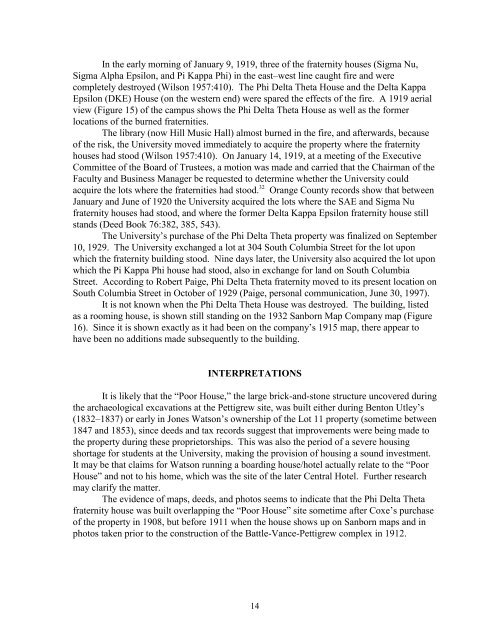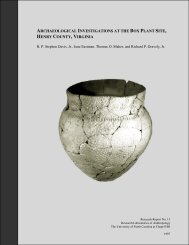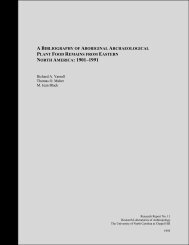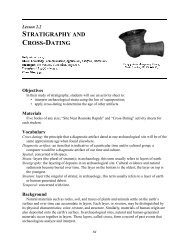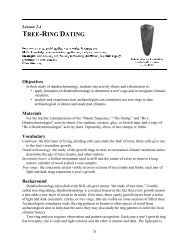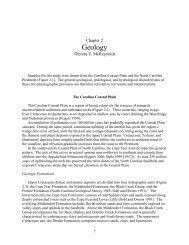Download pdf version - 42.3 MB - Research Laboratories of ...
Download pdf version - 42.3 MB - Research Laboratories of ...
Download pdf version - 42.3 MB - Research Laboratories of ...
You also want an ePaper? Increase the reach of your titles
YUMPU automatically turns print PDFs into web optimized ePapers that Google loves.
In the early morning <strong>of</strong> January 9, 1919, three <strong>of</strong> the fraternity houses (Sigma Nu,Sigma Alpha Epsilon, and Pi Kappa Phi) in the east–west line caught fire and werecompletely destroyed (Wilson 1957:410). The Phi Delta Theta House and the Delta KappaEpsilon (DKE) House (on the western end) were spared the effects <strong>of</strong> the fire. A 1919 aerialview (Figure 15) <strong>of</strong> the campus shows the Phi Delta Theta House as well as the formerlocations <strong>of</strong> the burned fraternities.The library (now Hill Music Hall) almost burned in the fire, and afterwards, because<strong>of</strong> the risk, the University moved immediately to acquire the property where the fraternityhouses had stood (Wilson 1957:410). On January 14, 1919, at a meeting <strong>of</strong> the ExecutiveCommittee <strong>of</strong> the Board <strong>of</strong> Trustees, a motion was made and carried that the Chairman <strong>of</strong> theFaculty and Business Manager be requested to determine whether the University couldacquire the lots where the fraternities had stood. 32 Orange County records show that betweenJanuary and June <strong>of</strong> 1920 the University acquired the lots where the SAE and Sigma Nufraternity houses had stood, and where the former Delta Kappa Epsilon fraternity house stillstands (Deed Book 76:382, 385, 543).The University’s purchase <strong>of</strong> the Phi Delta Theta property was finalized on September10, 1929. The University exchanged a lot at 304 South Columbia Street for the lot uponwhich the fraternity building stood. Nine days later, the University also acquired the lot uponwhich the Pi Kappa Phi house had stood, also in exchange for land on South ColumbiaStreet. According to Robert Paige, Phi Delta Theta fraternity moved to its present location onSouth Columbia Street in October <strong>of</strong> 1929 (Paige, personal communication, June 30, 1997).It is not known when the Phi Delta Theta House was destroyed. The building, listedas a rooming house, is shown still standing on the 1932 Sanborn Map Company map (Figure16). Since it is shown exactly as it had been on the company’s 1915 map, there appear tohave been no additions made subsequently to the building.INTERPRETATIONSIt is likely that the “Poor House,” the large brick-and-stone structure uncovered duringthe archaeological excavations at the Pettigrew site, was built either during Benton Utley’s(1832–1837) or early in Jones Watson’s ownership <strong>of</strong> the Lot 11 property (sometime between1847 and 1853), since deeds and tax records suggest that improvements were being made tothe property during these proprietorships. This was also the period <strong>of</strong> a severe housingshortage for students at the University, making the provision <strong>of</strong> housing a sound investment.It may be that claims for Watson running a boarding house/hotel actually relate to the “PoorHouse” and not to his home, which was the site <strong>of</strong> the later Central Hotel. Further researchmay clarify the matter.The evidence <strong>of</strong> maps, deeds, and photos seems to indicate that the Phi Delta Thetafraternity house was built overlapping the “Poor House” site sometime after Coxe’s purchase<strong>of</strong> the property in 1908, but before 1911 when the house shows up on Sanborn maps and inphotos taken prior to the construction <strong>of</strong> the Battle-Vance-Pettigrew complex in 1912.14


